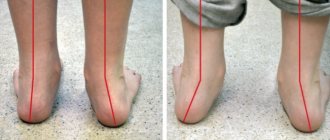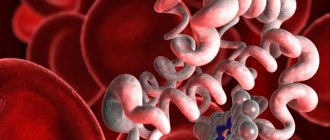Symptoms of celiac disease
Usually, celiac disease is not noticed immediately, explains pediatric gastroenterologist Lyubov Zakharova. In newborns, problems begin after introducing complementary foods, that is, cereals.
Symptoms of celiac disease can vary widely, but there are five main ones:
- the child becomes lethargic and pale, he has a dull look;
- he does not gain weight or height;
- there are disturbances in the digestion of food, stomach pain, diarrhea, bloating, nausea, lack of appetite;
- the most common symptom is diarrhea, up to 10 or more times per day,
- children suffer not only physically, but also mentally: there is isolation, increased excitability, and mood swings.
Even very small amounts of gluten can cause symptoms.
Celiac disease or gluten intolerance: symptoms in adults and children
Most often, the disease manifests itself 1.5-2 months after cereal products are introduced into the baby’s diet. Manifestations of a pathological condition are possible after an intestinal infection, ARVI, which become provocateurs and allow one to detect characteristic signs.
But development is possible without accompanying conditions. How do you know if you have celiac disease? Unfortunately, only a gastroenterologist can accurately determine the diagnosis. But you can answer several questions yourself - yes or no. If most of them evoke familiar and even habitual conditions, make an appointment with a specialist to clarify the diagnosis.
- Do you often have mood swings?
- Do you have a poor appetite (do you force yourself to eat)?
- Are you underweight and having difficulty gaining weight?
- Do you suffer from diarrhea, frequent bowel movements or persistent constipation?
- Do you get very tired during the day?
To roughly determine gluten intolerance or celiac disease, you need to know how it manifests itself and what signs of allergies occur in infants and adults.
For kids it is:
- Abnormally increased fecal output.
- Loose stools.
- Swollen (“frog”) belly.
- Increased fluid content in intestinal loops.
- Light weight.
- Bone changes characteristic of rickets.
- Retarded growth and development.
- Involuntary muscle contractions.
- Deterioration of the condition of hair, nails, skin.
Against the background of poor nutrition, exacerbations and addition of diseases that complicate the course of celiac disease are observed.
This was a description of how gluten intolerance manifests itself and what is accompanied by it in children, but here are its signs in adults (we note right away: they are not much different from those noted in infants):
- Foul-smelling feces, stools can be either light in color or interspersed with areas of different colors. Most often, the urge occurs two or more times a day. Prolonged constipation is also possible.
- The circumference of the abdomen increases, it seems to swell and become hard.
- Pain in the area near the navel, which intensifies after eating (after 3-5 hours).
- Loss of body weight.
- Lack of appetite or its sudden sharp increase.
- Skin rashes are called atopic dermatitis.
- A complex of allergic reactions from the respiratory system.
- Nervous system disorders: aggression, irritation, depressive syndromes, sleep disorders.
- Manifestations of phosphorus and calcium deficiency: bone pain, frequent fractures, problems with tooth enamel, carious lesions.
Nutritional Features
Patients with celiac disease are forced to constantly follow a gluten-free diet, only then can they live a full life.
“Celiac disease is treated only with diet; you do not need to take medications. Wheat, rye, barley, oats and products made from them have to be excluded from the diet. That is, the menu does not include white bread, baked goods, sausages, semi-finished products, chocolate bars, cookies, or cakes. Wheat flour, for example, can be replaced with rice flour. You can eat meat, fish, all fruits and vegetables. They sell pasta made from buckwheat flour,” explained Lyubov Zakharova.
Symptoms
The disease begins to manifest itself in infancy, when foods made from wheat, rye, barley, and oats are included in the diet. Further, in the absence of treatment, the symptoms of celiac enteropathy intensify during childhood, and decrease in adolescence, but at the age of 30-40 they resume again Source: Mikhalik D.S. Celiac disease: disease and lifestyle / D.S. Mikhalik [and others] // Zemsky doctor. - 2012. - No. 4. - P. 35-38. . In many patients, the symptoms of the disease can be very mild, so the disease is not recognized in childhood and adolescence, and the diagnosis is first made only in middle or old age.
The symptoms of celiac disease in children and adults are somewhat different. Thus, in children the presence of pathology can be suspected by the following symptoms:
- lag in weight gain;
- rickets;
- frequent regurgitation, vomiting;
- pain in the abdomen;
- change in stool (foamy consistency, unpleasant odor);
- diarrhea;
- swelling;
- early caries, delayed tooth growth;
- weakening of the immune system.
During adolescence, girls have an increased risk of polycystic disease, and boys may experience sexual dysfunction.
In adults, signs of the disease are as follows:
- alternating diarrhea and constipation;
- feces mixed with blood;
- anemia;
- blood clotting disorder;
- low pressure;
- bloating and flatulence;
- cramping pain in the navel area;
- nausea and vomiting;
- weight loss;
- caries, frequent stomatitis;
- changes in the skin (rash, peeling);
- arthritis;
- sexual dysfunction;
- menstrual irregularities;
- reduction in the size of the spleen;
- inflammatory processes in the liver.
10% of patients with celiac disease experience neurological symptoms - cerebral ataxia, neuropathy, epilepsy, headache. Approximately every third patient with celiac disease experiences depression Source: Mikhalik D.S. Celiac disease: disease and lifestyle / D.S. Mikhalik [and others] // Zemsky doctor. - 2012. - No. 4. - P. 35-38. .
Where to buy gluten-free food
In Cherepovets, a selection of gluten-free products is only available in supermarkets, and even then not in all. A special department operates in a pharmacy on Pervomaiskaya. But gluten-free food costs much more than regular food.
“I live in the Zasheksninsky district. We sell gluten-free bread, pasta, flour, cookies and waffles only at Lenta. If you want something else, you have to go to Zarechye. Gluten-free products are very expensive: bread costs 254 rubles for 250 grams, a package of waffles for one evening costs 270 rubles, 400 grams of pasta costs 259 rubles, says Diana Pankova, a Cherepovets resident. “I have weaned myself off bread since childhood, but there are people who cannot live without buns.” When I walk past a bakery, especially when I’m hungry, of course I want a pie, but now it’s easier to perceive: you can’t do that and that’s it. And before it brought me to tears. I don’t buy semi-finished products - it’s not clear what they put in there.”
Causes of celiac disease
Immunological. This theory is based on the fact that people who are intolerant to gluten have certain antibodies to it in their blood. In addition, autoimmune antibodies to intestinal cellular structures are detected. Intraepithelial lymphocytes, the number of which is increased, perceive gluten entering the body as something foreign. As a result, they begin to damage the intestines.
Enzymatic. This theory is based on the absence of an enzyme in the small intestine that can break down ingested gluten. This assumption has a right to exist, however, there is no evidence for it. After all, if a person adheres to a diet, the enzymes in the intestines are fully restored.
Viral. Studies have revealed that the overwhelming number of sick people have an increased level of antibodies to one type of adenovirus. However, the disease cannot develop as a result of an adenovirus infection, since it is congenital. The thing is that gluten and adenovirus have a similar antigenic state.
Pathoreceptor. This theory is based on the fact that the inner surface of the intestines of sick people has certain abnormalities. They are associated with a violation of the protein composition in the small intestine, as a result of which it is not able to absorb gluten.
It is worth noting that most scientists consider the immunological theory to be the most likely. However, it is not worth rejecting the remaining assumptions; it is more advisable to combine them. As a result, the following picture is formed: due to the lack of a special enzyme, the body is not able to break down gluten, and as it accumulates, the intestines are poisoned with toxins. It, in turn, gives a reaction by using certain receptors. In this “struggle,” damage to the intestines occurs, and its ability to digest and absorb is impaired. As for adenoviruses, they are considered a possible provocateur of the immune reaction to gluten that has entered the intestines.
Catering and gluten-free food
Most people with celiac disease are forced to avoid catering establishments or order a special menu from them in advance.
“I stopped going to cafes because I know there will be problems,” continues Diana Pankova. — Employees can’t always help; usually they don’t really know what gluten is, much less where it is found. They need to explain. I always feel awkward. The menu often does not list all the ingredients, for example, sauces - what do they consist of? Many dishes contain gluten in one way or another. The meat is rolled in flour or breadcrumbs. You constantly have to ask the waiters to go to the chef and find out. If I go to a cafe, I always order the same dish that I’m sure of. In Europe, restaurants write on the menu: “Gluten-free” or “May contain gluten.”
Celiac disease (gluten enteropathy)
With this hereditary condition, in response to the intake of gluten, or more precisely, one of the fractions of this protein called gliadin , an immunological reaction develops on the mucous membrane of the small intestine. As a result of this immunological conflict, the mucous membrane atrophies and ceases to function normally. The supply of nutrients is disrupted; damaged intestinal villi do not absorb broken down proteins, fats, carbohydrates, vitamins, macro and microelements. As a result, the child suffers from frequent fatty stools, bloating and abdominal pain. Such children gain weight poorly, have decreased appetite, sleep problems, and neuropsychological development disorders.
It is important that if you follow an agliadine (or gluten-free) diet, the villi can recover over time. It must be remembered that untreated or late diagnosed celiac disease threatens a number of complications, including infertility, osteoporosis, intestinal cancer, and neurological disorders.
How to eat in kindergarten and school
In Cherepovets, kindergarten No. 114 has been running groups for children with celiac disease for several years.
“My daughter goes to kindergarten No. 114, where there is a gluten-free menu. The fee for such a kindergarten is slightly higher: in a regular kindergarten a day costs 123 rubles, but here it is 177,” says Elena Topnikova, mother of a six-year-old child with celiac disease. “Many people, when they hear that we have celiac disease, begin to gasp and ask how we eat. But there is nothing wrong with our eating habits. We are on a diet and only eat products labeled “Gluten Free”. I always read the ingredients of products. When we go to a cafe, we allow ourselves fruit and vegetable salads, but we check whether fruits, vegetables and bread are cut on separate boards. At home and in the garden, the diet is strict, and we rarely go to cafes.”
In a regular kindergarten, parents agree on meals with the management. At school, the responsibility for feeding children rests entirely with parents.
“My daughter was diagnosed with celiac disease at age five. She's nine now. We immediately went on a diet, but at first it was very difficult to find food. It's easier now. In the kindergarten, by agreement, we were provided with a replacement for products with gluten. The school didn’t cooperate, so my daughter now takes food with her,” says Vologda resident Oksana Petryashova.
As the Commissioner for Children's Rights Olga Smirnova notes, in educational institutions of the Vologda region there is no systematic work on organizing nutrition for children with digestive problems: “Unfortunately, such work does not exist. School leaders were given recommendations on organizing meals for children with dietary needs in accordance with the newly adopted methodological recommendations by Rospotrebnadzor.”
Gluten-free: a whim or a necessity?
Over the past few years, various labels have begun to appear on food labels. Manufacturers are proud that their products do not contain sugar, GMOs, artificial colors, flavors or, for example, gluten. In many cases, these clarifications are nothing more than a marketing ploy.
What is gluten?
Gluten (gluten) is the name given to proteins that are found in the seeds of cereal plants that are consumed by humans in one form or another.
This can be semolina, pure wheat, spelt, rye, barley, kamut, other grains and dishes prepared from them.
At the same time, gluten does not necessarily look like porridge or a side dish on your plate - it is used as a binding element in sauces (for example, mayonnaise or salad dressing), sausages and processed foods, cosmetics, and even some medicines and dietary supplements.
Where is there no gluten?
Due to the popularization of the idea that gluten is bad for you, there are entire lists of gluten-free foods for those following a gluten-free diet.
Typically, substitutes for classic baked goods, pasta and confectionery are made from beans, lentils, corn, buckwheat and quinoa. These plants do not contain gluten.
What is gluten intolerance? Is this when your stomach hurts?
Approximately 1% of the world's population has a genetically predisposed gluten intolerance - celiac disease. Contrary to popular belief, it is not a food allergy, but an autoimmune disease that damages the small intestine.
However, the symptoms of celiac disease vary - these can include abdominal pain, diarrhea, bloating, vomiting, anemia, joint pain, numbness in the limbs, and even anxiety and depression.
Scientists suggest that even a slight sensitivity to gluten is developed in only 6-7% of the world's population - these are those who find it difficult to digest a sandwich or roll they eat, but whose intestines are most likely in perfect order.
Are gluten products generally harmful?
Recent research is exposing gluten-free diets and refuting the idea that intolerance to this protein is a widespread phenomenon.
Thus, Dr. Daniel A. Loeffler, an assistant professor at Harvard Medical School, argues that by giving up gluten, “people who are sensitive to gluten may feel better, but most of the population will not notice significant benefits from this practice.” Modern science does not know about any surge of energy, improvement in sleep and mood - this is nothing more than a myth, unless you suffer from gluten intolerance.
Can going gluten-free be dangerous?
Yes maybe. By giving up gluten (the basis of the so-called paleo diet, which greenlights fruits, vegetables, meat, seafood, nuts and seeds, but avoids all dairy, grains, legumes and vegetable oils, as well as refined or processed foods), you are dooming yourself for a deficiency of fiber and certain microelements (for example, B vitamins). In addition, a total refusal of gluten leads to a deficiency of iron and folic acid - basic microelements necessary for the functioning of the cardiovascular, musculoskeletal and reproductive systems. In addition, there are studies that confirm the connection of a gluten-free diet in healthy people with the development of type 2 diabetes and heart disease.
The worst thing is when parents without an established diagnosis of celiac disease refuse to give their children foods containing gluten.
A few years ago, a bill was even put forward in Italy, according to which parents who impose a diet on their children could face up to four years in prison.
At that time we were talking about vegetarianism, but the essence is clear. Scientists agree that children need a variety of foods to help ensure full physical and intellectual development.
So is there gluten or not?
If you have not been diagnosed with intolerance, you should not limit your diet - follow common sense and recommendations from the field of proper nutrition: it is better to leave fluffy sweet rolls on the supermarket shelf, and put whole grain bread in the basket.
Don't forget that most gluten-containing foods are quite high in calories - if you are losing weight, make sure that the balance of your daily intake of calories, proteins, fats and carbohydrates is not upset by the next plate of pasta with sauce.
Read also: Food from semi-finished products: harmful or not?
If you suspect that you have gluten intolerance, do not rush to give up your usual products and follow the lead of marketers. First, visit your doctor - celiac disease can be diagnosed using a duodenal biopsy and a high-precision blood test (for antibodies to endomysium, tissue transglutaminase and gliadin). If intolerance is confirmed, then we can talk about the need for a gluten-free diet - unfortunately, today this is the only method of treatment.
Remember that any suspicions and symptoms that are somehow related to your diet and health in general should not be left to chance.
Go to doctors on time, follow recommendations and do not ignore prescribed tests. And be healthy!
Maria Ruskova
__________________________________
Gluten-Free Foods, Celiac Disease foundation
Think You're Sensitive to Gluten? Think Again
How Many People Have Gluten Sensitivity, Verywell
No effects of gluten in patients with self-reported non-celiac gluten sensitivity after dietary reduction of fermentable, poorly absorbed, short-chain carbohydrates, NCBI
Going gluten-free just because? Here's what you need to know, Harvard Health Publishing
Risks of a Gluten-Free Diet, Science-Based Medicine
Photo depositphotos.com
The author's opinion may not coincide with the editor's opinion
Parents' advice
According to parents, celiac disease manifests itself in different ways: one child simply “lags behind” in weight and height, another has a stomach ache.
1200 rubles per month - allowance for a child with celiac disease in the Vologda region
“My husband often caught colds, the doctor suspected celiac disease and sent him for tests. The disease was confirmed. Celiac disease is a hereditary disease, so my daughter was tested, although, as doctors say, it is transmitted to girls to a lesser extent than to boys, recalls Elena Topnikova. — The first time the test gave a negative result, but a year later abdominal pain appeared, we took the test again, and celiac disease was confirmed. What mistakes are there in nutrition? You need to listen to your body: some people will even feel a minimum of gluten, but for others it’s enough to exclude “overtly” gluten products.”
As Oksana Petryashova says, the most dangerous period is up to a year after the introduction of complementary foods. It is worth taking a test for celiac disease (usually a paid test directed by a gastroenterologist) if the child’s weight gain has stopped and growth has slowed.
“There was no bulging abdomen or any rashes, only weight and height caused concern, so for a long time we did not understand that it was celiac disease,” explains Oksana Petryashova. — When my daughter grew up, she began to say that her stomach hurt. When choosing products, you need to carefully read the ingredients. To my surprise, on the rice flour, where only rice was listed as an ingredient, it was written in small letters that it may contain gluten. The crossed out ear symbol on products makes selection easier. If you eat gluten, you won’t notice anything right away, and that’s the problem. My baby's stomach starts to hurt after a couple of days. We review all the food and usually find out that she ate the forbidden food more than once. And it takes a long time for gluten to leave the body. We dream that they will invent a food additive that will allow the body to process gluten.”
Lyudmila Makarova
Antibodies and diagnostic criteria for celiac disease
The first description of endomysium antibodies (AEA) in celiac disease dates back to 1983, when they were accidentally detected in the esophagus of a monkey during an examination of patients with dermatitis herpetiformis (Chorzelsky et al.). Since then, the detection of antiendomysial antibodies has become the main method for serological diagnosis of celiac disease, largely replacing the less clinically reliable antibodies to gliadin.
In 1997, Dieterich, by sorption with purified protein obtained from cell lines, showed that the main antigen of AEA is tissue transglutaminase. Tissue transglutaminase (TSG) is a common calcium-binding enzyme. Its main function is to form cross-links between proteins through the reaction between glutamine in one protein and lysine in another. There are 5 isoforms of this enzyme, which differ in tissue localization. TSH type 2 (TSH2) is predominantly expressed in the stomach. The target of antibodies in dermatitis herpetiformis, which is closely related to celiac disease, is TSH type 3, which is expressed in the skin. Normally, the activity of this enzyme is maximum in the cells of the basal layer of the intestinal epithelium, as well as in the submucosal layer. In patients with celiac disease, there is increased expression of TSH in all layers of the intestinal mucosa. Alpha-gliadin is 60% composed of the amino acid glutamine, which is deaminated by the enzyme tissue transglutaminase. Deamination of gliadin leads to the formation of neoepitopes containing the negatively charged amino acid glutamate, which have a high affinity for HLA-DQ2 and DQ8, the carriage of which predisposes to the development of celiac disease. It should be noted that the HLA-DQ2 genotype is observed in 25-30% of Europeans, but not all of them develop celiac disease.
Tissue transglutaminase also deaminates a number of connective tissue proteins in the composition of endomysial and reticulin fibers. Thus, the immune response to an exogenous antigen leads to the appearance of antibodies to alpha-gliadin, as well as autoantibodies directed against the autoantigens endomysium, reticulin and tissue transglutaminase.
First-generation enzyme immunoassays used animal antigens, primarily purified enzyme from guinea pig liver, to detect antibodies to tissue TSH. However, the low level of protein purification, as well as the presence of species-specific epitopes, reduced the specificity of the test. The second generation ELISA was based on recombinant human TSH. Due to their high analytical parameters, these ELISA tests have largely replaced the nRIF method for detecting antibodies to endomysium. The high sensitivity of ELISA test systems undoubtedly improves the diagnosis of celiac disease, however, test systems from many manufacturers have low specificity, especially in the differential diagnosis of celiac disease and other gastrointestinal diseases. A study of the antigenic structure of the TSH molecule showed that the main epitope of antibodies in celiac disease is conformational and is formed by the core of the enzyme molecule. Autoantibodies to TSH, characteristic of celiac disease, suppress the activity of the enzyme. At the same time, antibodies to TSH, found in patients with autoimmune hepatitis, cirrhosis, and viral infections, are directed to the external domains of the TSH molecule. This may explain the lower specificity of antibodies to TSH compared to the detection of AEA.
When comparing antibodies to endomysium of the IgA class and antibodies to TSH antibodies, it was shown that AEA are significantly more specific, but less sensitive. This allows us to recommend the detection of antibodies to TSH as a screening for autoantibodies in celiac disease, however, if the result of the screening test is positive, the determination of antibodies to endomysium is recommended.
For laboratory diagnosis of celiac disease, detection of antibodies to TSH of the IgA and IgG classes is used. The most specific test is to detect antibodies to TSH of the IgA class, which are observed in 95% of patients with the onset of celiac disease. IgA autoantibodies can be found in blood and other body fluids, including saliva and bile. Detection of IgG autoantibodies is somewhat less specific, as they can be observed in other inflammatory diseases of the gastrointestinal tract, but they can be used to diagnose celiac disease in individuals with selective IgA deficiency. There are rapid tests based on the detection of IgA anti-TSH in saliva, but they have low sensitivity.
Antibodies to gliadin have remained the main method of immunological diagnosis of celiac disease for a long time (since the 50s of the last century). Strictly speaking, gliadin is not an autoantigen, but an immune reaction against gliadin triggers a cascade of immune reactions that results in the development of an autoimmune disease and the appearance of autoantibodies. The study of the molecular structure of proteins in gluten led to the identification of a common linear immunodominant amino acid sequence QPEQPFP. The last glutamine residue in this structure is the target for the enzyme tissue transglutaminase, under the action of which it is converted to glutamate. Changing the charge of the molecule leads to better binding to HLADQ2/8 and stimulation of the immune response.
For a long time, the ELISA method (first generation tests) was used to determine antibodies to gliadin. Antibodies to purified wheat alpha-gliadin are relatively nonspecific tests. For laboratory diagnosis of celiac disease, the determination of antibodies to gliadin of the IgA and IgG classes is used. Antigliadin IgG antibodies are sensitive but very nonspecific and can be considered an indicator of inflammation in the gastrointestinal tract. Antibodies of the IgA class are observed in 30-40% of patients with celiac disease.
Currently, only tests for detecting antibodies to deaminated peptides (DGP peptides) are recommended for practical diagnosis. These tests are based on the detection of antibodies to the immunodominant amino acid sequences of gliadin. They are somewhat inferior in sensitivity and specificity to the detection of antibodies to tissue transglutaminase IgA and antibodies to endomysium.
Detection of antibodies using second-generation tests for the diagnosis of celiac disease showed that antibodies have very good clinical diagnostic parameters (i.e., they are found exclusively against the background of celiac disease and are not found in other autoimmune diseases of the gastrointestinal tract). Moreover, detection of antibodies to tissue transglutaminase in a titer 10 times higher than the upper limit of normal allows us to predict with 100% probability the presence of changes in the intestinal wall. Confirmation of high IgA TSH titers by detecting endomysial antibodies provides almost absolute certainty of the diagnosis.









